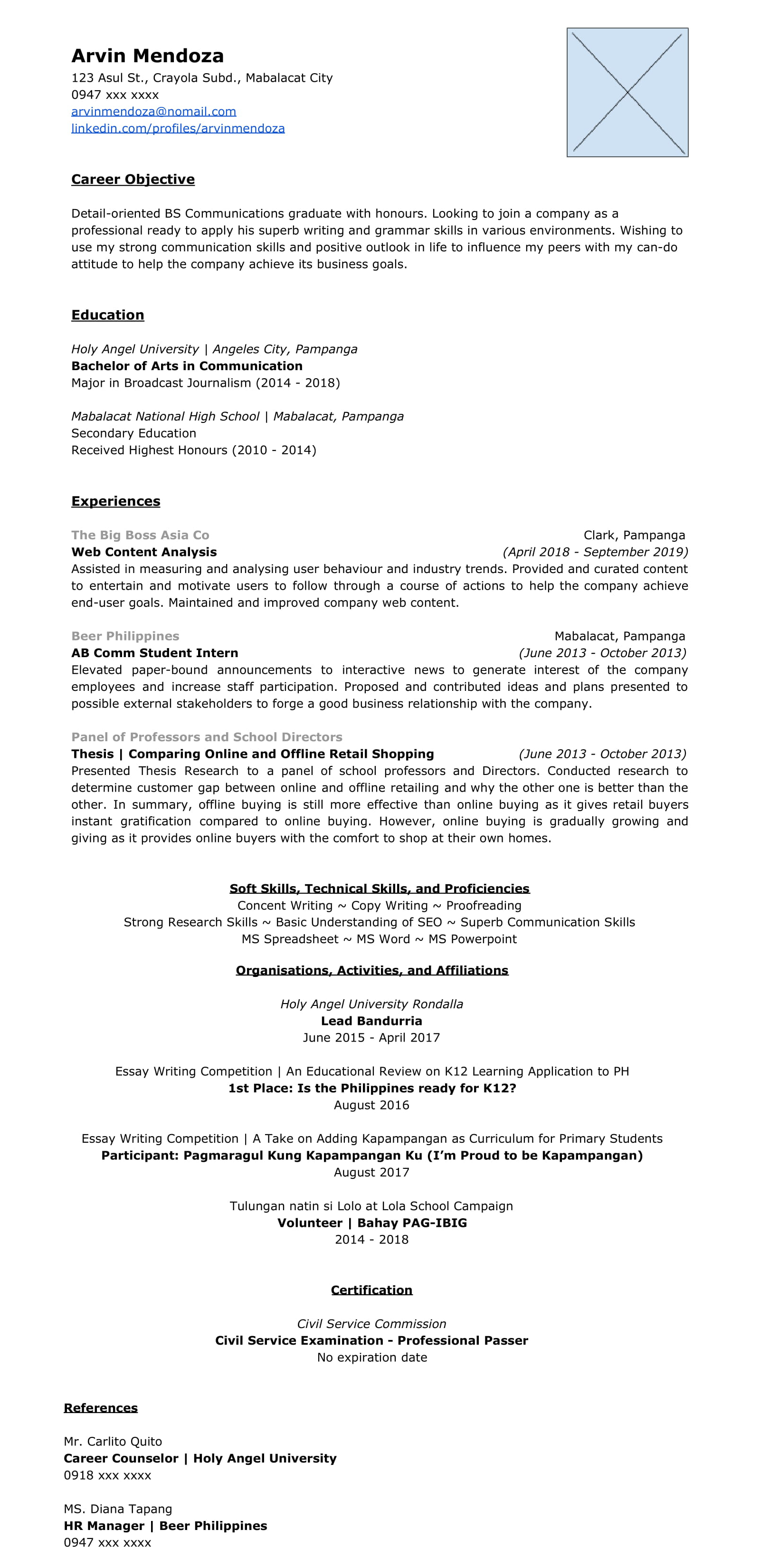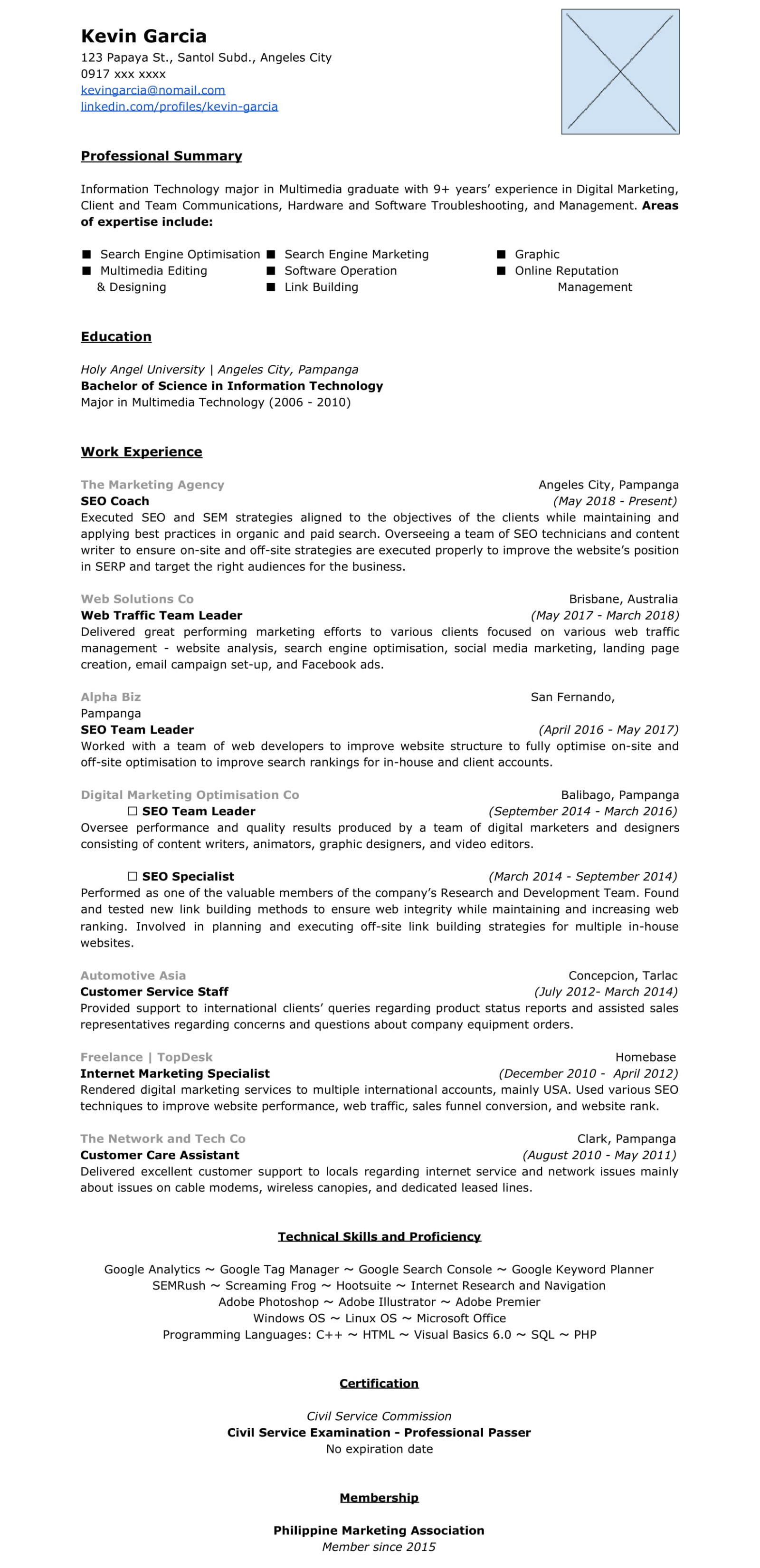PROUD WINNERS OF BEST PLACE TO WORK
by Jobs360 | Oct 15, 2019 | Job search tips

The content of the applicant’s CV affects his candidacy. Recruiters check whether applicants pass based on a quick review of the candidate’s CV. If their CV lacks valuable information like contact details or summary of previous job experiences, recruiters will put them on the last-to-interview or will-not-interview pile.
What is a CV? The term CV is an acronym of Curriculum Vitae – a business document applicants use in a job search. It is more detailed than a resume and contains an applicant’s complete contact details, employment history, and skills.
Learning how to write a CV is important these days. It has evolved as the ticket to get interviews with recruiters.
A fresh graduate’s frustration can start from not knowing how to write a CV. Professional CVs are quite different from a young applicant’s CV. There are sections from professional CVs that are inapplicable to include in a fresh graduate’s CV.
Writing your complete contact information is important. Recruiters will need these to contact you later when you are asked to come in for an interview. Include your full name, home address, mobile number, and working personal email address.
Ensure that there are no spelling mistakes in your email address and there are no additional numbers added to your correct mobile contact number.

Include the URL of your LinkedIn profile on your resume. This is to help recruiters easily access your profile and check if the content on your resume is aligned with the content on your online business profile.
Note that it’s important to update your LinkedIn profile from time to time to help recruiters find you online easily.
It’s advised to have your photo taken by professionals for a cleaner and more professional look. Avoid using photos from your social media profiles like Instagram and Facebook. Make sure you look presentable in your photo and that you are wearing presentable clothes – collared shirts, polos, or blouses.
A career objective is a section on a resume where applicants can sell their skills and abilities. This is where they should highlight their most relevant skills and experiences. This section is also a place where they can state what type of career they’re seeking in a company.
The basics of writing a great career objective are starting with stating 2-3 relevant skills to the position you’re applying for. Then add a few ways you can help the company grow. Make sure to keep this section 30 – 50 words short.
It’s important to note down your educational attainments. Don’t be shy to state if you’re an undergraduate or if you’ve acquired certifications instead of diplomas.
Note that many foreign-owned companies that offer employment opportunities here in the Philippines don’t tend to focus on this section. However, it would still be valuable for them to have a brief understanding of your educational background, so include this section no matter what.
What can fresh graduates and undergraduates consider as a professional experience when writing a CV? Everything. Summer jobs, part-time jobs, and on-job-trainings are all considered experiences.
Include all important and necessary details in this section which are the company name, location, position, and length of your employment from your previous employers.
What has a student’s thesis got to do with it? According to an account manager in one of the Philippine’s largest marketing companies, a thesis can show hiring managers a glimpse of the applicant’s dedication to finish and excel in their work.
Write the title of your thesis and include a summary that outlines the goal or findings of your thesis. Make sure that your brief description is on point and no longer than 100 words.
Every student has developed skills during their scholastic years. Some develop programming skills as their focus is IT-related, some thrive in the writing department, while others grow to be leaders.
List down your skills and proficiencies. If you’re an IT graduate who has taken extra classes to learn another programming language and has been proficient in it, include that.
This section showcases the kind of student you were in graduate school. Add a list of organisations you are included in, list down the activities that you’ve joined in, and enumerate your affiliations.
List it down even if it may seem like a silly thing for you. For example, winning a writing competition can be a big deal if you’re applying for a content writing role. This may be small but it is an important detail that can make a difference in your future career.
Certifications and seminars are serious matters in the professional world. It’s an important section to add when writing CVs. If you have certifications from government agencies like CSC or seminars related to your industry, add them.
Educational institutions invest to be associated with nationwide societies that allow their students to explore the in-depth learnings, challenges, and the opportunities they offer. For example, marketing students have the option to join a nationwide society fostering knowledge sharing for aspiring marketers across the country. Include these kinds of memberships as they add credibility to your CV.

Aside from young professionals and aspiring experts, experienced professionals still make mistakes regarding what to include in their CVs and not. However, it’s not as necessary for them to tidy up their CVs given their professional experience and history.
Their CVs work, it does. However, they have probably missed bigger opportunities if they only updated and tweaked their CVs a bit.
Writing complete contact information is a basic rule for professionals submitting a CV, resume, and biodata. Make sure that the following information is written on CV: your full name, home address, mobile number, and primary working email address.
As professionals know, LinkedIn is an applicant’s secondary business profile. Regularly update your LinkedIn profile and make sure that the content on your business profile is aligned with your CV.
The rule of thumb is to use an updated photo no later than 2 years. Invest to have your CV photo taken by a professional photographer in a studio. Make sure to wear presentable clothes with a collar or have the professional replace your top with a templated business attire.
A professional summary is very different from a career objective. For experienced professionals, it would be better to write a professional summary. This to have you showcase your experience for the past few years, your expertise, and new relevant skills you’ve acquired. A technique many professionals with well written CVs use is including the number of years of experience in a certain field. This gives more credibility to the other things written in this section like proficiency in using certain tools and such.
Include your educational background in your CV. Most hiring companies require certain scholastic attainments – especially tertiary education. Write the institution’s name, address, your degree, and the years you attended the institution.

List your professional experiences. Start with your most recent job experience and include the following details: company name, company address, position, hiring date to last day at the company, and a summary of tasks and achievements accomplished in the company.
It’s important to list all your skills and expertise in your CV. However, what should you include? The key tip here is to list down skills and competencies you have a working understanding of, great knowledge of, and proficiency with.
Certificates and list of recently attended seminars are advantages. This rings most true to professionals in the finance, education, and the IT industry. Certifications and seminars are actual proofs that you have been updating yourself with the latest industry trends and news. Separate the seminars from the certificates so recruiters can easily identify which is which. Make sure to list the seminars you attended chronologically.
What is a professional membership? It’s a membership program from a local society or institute that promotes excellence, updates, and news in their field. Such societies and institutes foster sharing of resources and opportunities among their members. The Philippines have societies and institutes like these. Some cater to professionals while others cater to students aspiring to be the best in their field.
Always edit your font. Make sure you are using readable font style and reasonable font size. Don’t make everything too small or too big.
Keep font size between 10 to 12 and edit font style to Times New Roman, Bell MT, Georgie, Arial, and Tahoma. These will help hiring managers read your written CV easier.
Spell and grammar check is an important task to do after you have written your CV. Simple spelling mistakes can tarnish your reputation, especially if you’re an experienced worker in the field of digital marketing and journalism.
You don’t have to use big words. The important key is to make sure haven’t misspelt words and that your subjects, verbs, and pronouns agree with each other.
What’s the difference of PDF with Word? Well, in PDF, no one can edit details on your CV unless they convert it back to a .docx file. It’s important to have the original written copy of your CV saved in a .docx format then send the PDF version to the recruiters and hiring managers.
You won’t want a random file name. Renaming your files before sending it and saving it is one best practice that can save you time. Use your full name as the file name. Aside from easily navigating it on your folder, it helps the recruiters find your CV in their database easily.
Why is it important to hyperlink links in your CV? There are two ways recruiters review an applicant’s CV – by reviewing the printed version or by reviewing the online version. Many applicants submit their written CVs via email or social media platforms.
Hyperlinking your email address and online portfolios save recruiters several clicks to check your other online profile and it exhibits courteousness.
Formatting and margins are as important. Make sure the spacing between the lines in your written CV isn’t distracting the recruiter from reading the content of your CV. It’s advised to use single to 1.5 line spacing. Then adjust your margins on the top and bottom from 1 inch to .75 and the sides from 1 inch to .75 or .5 inch. This will help you create a cleaner look for your CV.
It’s necessary to write the full name of the organisation rather than its acronym. Many acronyms stand for different things and you don’t want to associate yourself with something dodgy. If your keen on writing the organisation’s acronym, add the full name of the organisation beside it.
What is considered to be unnecessary information in an applicant’s CV? Well, that depends on the organisation you are applying to.
Personal information like height, weight, and age are important details required in a biodata but not in a CV. Exclude such details when you’re using a CV to apply for blue-collared jobs. Learn the type of job you are applying for so you know which business document is more appropriate to use.
CVs are professional business documents. Avoid inserting graphic designs and other images that are unnecessary to add in a CV. If you wish to showcase your work, create a separate profile called a portfolio – a business document that exhibits your accomplishments and achievements from your previous job opportunities.

Learning how to write a CV doesn’t start and end with the content of your CV. It needs a lot of editing, checking, and making sure every detail is correct. All these are great practices in learning how to write an attention-grabbing CV that will surely land you the job.
Share the best practices you’ve been doing when updating your CV in the comments section below! We’d love to hear it.
If you have any questions, please feel free to ask.
Email: jobs@jobs360.com.ph
Call:
Sydney: +61 2 9119 2578
Philippines: +63 45 499 3268
Address: SHORE360, INC. Mercedes-Benz Center, Manuel A. Roxas Hwy, Clark Freeport, Angeles, Pampanga, Philippines 2009
Jobs360
A division of Shore360, Inc.